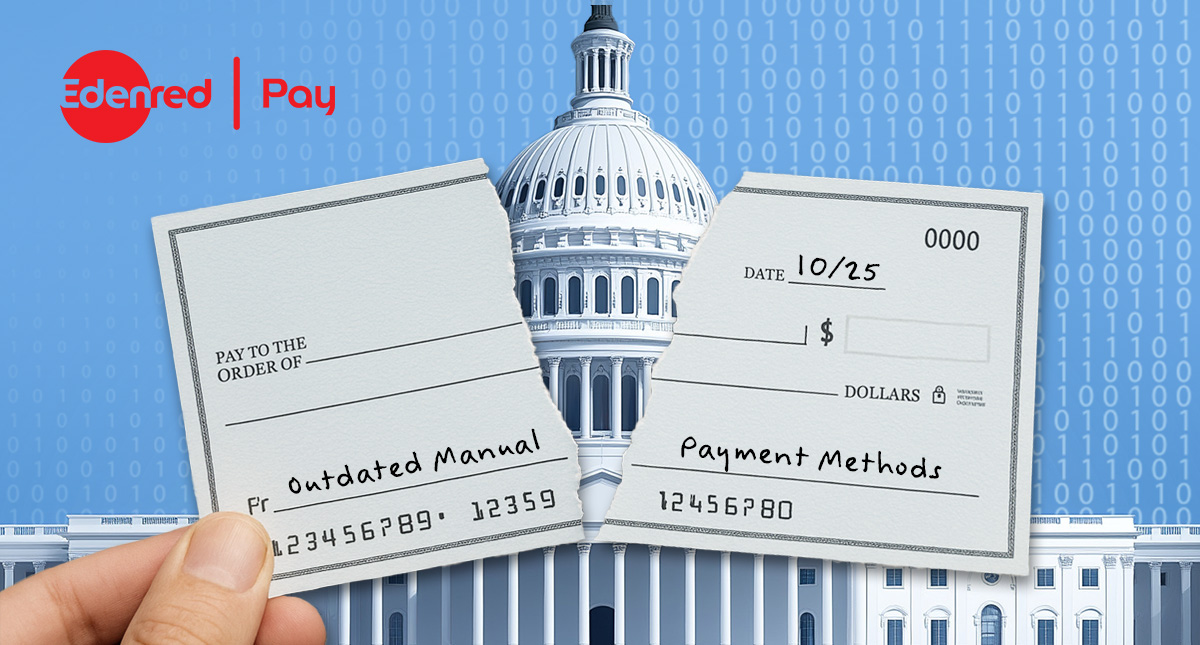The days of writing and mailing paper checks may finally be coming to an end. The federal government has announced plans to phase out paper checks for tax refunds and other disbursements, signaling that the nation’s largest payer sees no future in outdated, manual payment methods.
This is more than a bureaucratic policy shift. It’s a wake-up call for businesses everywhere.
If the U.S. government is moving away from checks, organizations of all sizes should recognize the urgency of accelerating their own transition to electronic payments to suppliers.
Continuing to rely on paper checks means clinging to an expensive, risky, and slow process while competitors reap the benefits of business-to-business (B2B) electronic payments. Electronic supplier payments are no longer a future consideration; they are today’s standard. Organizations that fail to act will not only lag in efficiency but will also put their financial operations at risk.
What Are Electronic Supplier Payments and How Do They Work?
Electronic supplier payments (sometimes referred to as integrated payablesA platform that consolidates all payment types – ACH, card, check – into one streamlined workflow.) replace the outdated practice of issuing paper checks with secure, digital transactions. Instead of printing, signing, and mailing checks – and waiting for suppliers to deposit and clear them – funds move electronically across established payment rails like ACH transfers, ACH+, or virtual cards. These methods create faster, more reliable, and more transparent payment experiences for both buyers and suppliers.
- Supplier onboarding and enablement. The first step in any accounts payable (AP)The amount a company owes to suppliers for goods and services received but not yet paid. automation program is enrolling suppliers so they can receive funds electronically. This includes collecting bank account details, validating ownership, and confirming preferred payment methods. Adding automation reduces manual data entry, strengthens compliance, and minimizes errors. By making enrollment seamless, organizations increase supplier participation and accelerate adoption of electronic supplier payments such as cards.
- Invoice approval and ERP integration. Payments only happen after invoices are captured, validated, and approved. AP automation platforms automatically match invoices to purchase orders (POs) and delivery receipts, route them for approval, and feed them into the enterprise resource planning (ERP) or accounting softwareA system for recording and managing a company’s financial transactions, often integrated with ERP and AP solutions. package. This reduces back-and-forth emails and calls, ensures accuracy, and eliminates bottlenecks that delay payments. The result is a clean, streamlined pipeline from invoice receipt to execution of digital payments.
- Payment execution and routing. Once approved, an invoice-to-pay system automatically selects the optimal method for each supplier. ACH might be used for one vendor, while another is paid via virtual cardA single-use or vendor-specific digital payment card used in B2B payments to improve control, visibility, and rebate potential. W to maximize rebateA financial incentive returned to the buyer based on specific criteria, such as using virtual cards or meeting spend thresholds. opportunities. This flexibility ensures suppliers get paid according to their preferences while organizations optimize cost and efficiency. Advanced invoice-to-pay platforms even allow for real-time payment decisioning and monitoring of payment status, reducing uncertainty and strengthening trust.
- ReconciliationThe process of matching financial records—such as payments and invoices—to ensure accuracy in accounting and reporting. and reporting. After B2B electronic payments are executed, digital systems feed real-time status updates back into accounting records. Dashboards provide instant visibility into cash outflows, aging invoices, and exceptions. This empowers finance leaders to forecast with more accuracy, identify trends, and spot potential issues before they escalate. It also simplifies audits by providing a complete electronic trail of payment activity.
- Exception handling and fraud controls. Inevitably, not every transaction goes as planned. Strong integrated payablesA platform that consolidates all payment types – ACH, card, check – into one streamlined workflow. solutions include tools for quickly resolving failures, disputes, or rejected payments. Built-in fraud detection, role-based controls, and audit logs add layers of protection that paper checks can’t match. By reducing vulnerabilities and streamlining resolution, companies lower risk exposure and enhance trust with their suppliers.
Why Electronic Payments to Suppliers Deliver More Value
If government agencies see checks as a relic of the past, the private sector should follow suit. Beyond eliminating paper, electronic supplier payments such as ACH, ACH+, and virtual cardA single-use or vendor-specific digital payment card used in B2B payments to improve control, visibility, and rebate potential. W transactions unlock a host of benefits that directly impact cost, visibility, and supplier relationships.
- Cost reduction and efficiency. Digital payments eliminate the hidden expenses of printing, postage, and manual handling. They also reduce the labor hours finance teams spend cutting checks and fixing errors. Invoice-to-pay automation ensures payments are routed accurately the first time, freeing staff to focus on strategic priorities such as data analysis, instead of clerical work. Over time, the savings compound into a significant competitive advantage.
- Speed and predictability. Electronic payments to suppliers land in accounts in days, sometimes hours, compared to the unpredictability of mailed checks. Faster paymentsA general term for modern payment methods that allow funds to move quickly – often in seconds – between financial institutions. improve supplier satisfaction and reduce inquiries about payment status. At the same time, organizations gain the ability to time payments strategically, holding onto cash until the last responsible moment. This balance strengthens both liquidity and supplier trust.
- Stronger supplier relationships. Suppliers thrive on reliability, and electronic supplier payments provide it. Prompt, predictable payments reduce disputes and foster collaboration. Businesses that consistently meet payment commitments often gain leverage in negotiations, such as improved terms and service level agreements (SLAs) or more lucrative early-pay discounts. These stronger relationships translate into long-term growth and resilience.
- Better control and visibility. Real-time dashboards give finance leaders the insights they need to manage cash flow effectively. Automated reconciliationThe process of matching financial records—such as payments and invoices—to ensure accuracy in accounting and reporting. eliminates guesswork and speeds up month-end close. Built-in fraud controls, advanced data encryption, bank account validation, and audit trails offer peace of mind that funds are secure, and processes are compliant. This level of transparency and control is a hallmark of modern AP automation.
- Scalability and flexibility. As organizations grow, check-based processes create choke points that demand more staff and resources. Integrated payablesA platform that consolidates all payment types – ACH, card, check – into one streamlined workflow. solutions scale effortlessly with transaction volume. Flexible integrated payablesA platform that consolidates all payment types – ACH, card, check – into one streamlined workflow. systems support multiple payment rails, so companies can adapt as supplier preferences evolve without overhauling their processes. This adaptability helps organizations stay resilient in a digital-first economy.
- Revenue and rebateA financial incentive returned to the buyer based on specific criteria, such as using virtual cards or meeting spend thresholds. opportunities. Virtual cardA single-use or vendor-specific digital payment card used in B2B payments to improve control, visibility, and rebate potential. W payments can generate rebates that turn accounts payable into a revenue stream. Instead of being a cost center, AP can actively contribute to the bottom line. These rebateA financial incentive returned to the buyer based on specific criteria, such as using virtual cards or meeting spend thresholds. opportunities can help offset technology investments or fund other strategic initiatives. For organizations under pressure to do more with less, this benefit is especially compelling.
Key Considerations When Evaluating Integrated PayablesA platform that consolidates all payment types – ACH, card, check – into one streamlined workflow. Solutions
Making the leap to electronic supplier payments isn’t just about adopting technology. It’s about choosing the right integrated payablesA platform that consolidates all payment types – ACH, card, check – into one streamlined workflow. strategy. The wrong solution can introduce complexity, frustrate suppliers, or fail to deliver ROI. Businesses should weigh these key factors.
- Supplier enablementThe process of onboarding suppliers to electronic invoicing and payment systems to streamline transactions. and adoption. No B2B electronic payments strategy works without supplier buy-in. Solutions that include onboarding support, education, and multi-method payment options reduce friction. Self-service supplier portals empower vendors to update their own information, speeding adoption and reducing administrative workload. Businesses should evaluate how well a solution can bring their unique supplier base into the fold.
- Flexibility and payment routing. Every supplier has different payment preferences, and every AP department has different priorities. A strong invoice-to-pay solution routes each payment to the method that balances cost, speed, and supplier satisfaction. The ability to flex between ACH, virtual cardA single-use or vendor-specific digital payment card used in B2B payments to improve control, visibility, and rebate potential. W, or network payment ensures universal coverage. Dynamic routing logic also safeguards against disruptions when preferences or conditions change.
- Integration with ERP and accounting systems. Payment processes must connect seamlessly to ERPs and accounting platforms. Look for AP automation solutions with proven integration capabilities that ensure clean data flow. API, webhook, and file-based connectivity options provide flexibility for different IT environments. Integration ensures electronic payments to suppliers are not only executed but also reconciled accurately.
- Security, controls, and auditability. With payment fraud risk at an all-time high, security is critical. The right invoice-to-pay solution will include bank account ownership verification, advanced data encryption, role-based permissions, and audit trails. These protections minimize risk while ensuring compliance with regulatory standards. Organizations should weigh the strength of a solution’s fraud prevention as heavily as its efficiency.
- Visibility and analytics. Real-time visibility into cash outflows and exceptions allows finance leaders to manage proactively. Configurable reporting helps monitor Key Performance Indicators (KPIs), track early-pay discount capture, and satisfy auditors. Analytics also identify opportunities for process improvement and cost optimization. Without robust reporting, the value of integrated payablesA platform that consolidates all payment types – ACH, card, check – into one streamlined workflow. is significantly reduced.
- Scalability and support. A supplier payment solution should grow with an organization, not hold it back. Scalability ensures the platform can handle higher volumes and more suppliers as operations expand. Supplier service teams and dedicated support make adoption smoother and keep vendors engaged. When evaluating, prioritize not just the technology but the partnership model that comes with it.
The Time to Act on Electronic Supplier Payments Is Now
The government’s move away from checks is proof that the days of paper payments are numbered. For AP departments, this isn’t a distant trend – it’s a call to action. By migrating to electronic payments to suppliers today, companies can reduce costs, improve supplier relationships, and gain the agility needed to thrive in a digital-first economy. Those who delay risk higher costs, greater exposure to fraud, and a widening gap with competitors who embraced electronic payments early.

Ready to elevate your B2B payments?
Whether you are automating for the first time, ready to refresh your existing technology, or looking for ways to complete the ‘last mile’ of automation, Edenred Pay can help. Let’s chat about your needs.







